Qutenza Dosage
Generic name: CAPSAICIN 179mg in 179mg;
Dosage form: patch
Drug class: Miscellaneous topical agents
Medically reviewed by Drugs.com. Last updated on Jul 8, 2024.
Important Dosage and Administration Instructions
- Do not dispense QUTENZA to patients for self-administration or handling. Only physicians or healthcare professionals are to administer and handle QUTENZA.
- Unintended exposure to capsaicin can cause severe irritation of eyes, mucous membranes, respiratory tract, and skin in healthcare professionals, patients and others .
- Because unintended exposure to capsaicin can cause severe irritation of eyes, mucous membranes, respiratory tract, and skin, when administering QUTENZA, it is important to follow these procedures:
− Administer QUTENZA in a well-ventilated treatment area.
− Wear only nitrile gloves when handling QUTENZA or any item that makes contact with QUTENZA, and when cleaning capsaicin residue from the skin. Do not use latex gloves as they do not provide adequate protection.
− Use of a face mask and protective glasses is advisable for healthcare professionals.
− Keep QUTENZA in the sealed pouch until immediately before use.
− Use QUTENZA only on dry, intact (unbroken) skin.
− In patients treated for neuropathic pain associated with diabetic peripheral neuropathy, a careful examination of the feet should be undertaken prior to each application of QUTENZA to detect skin lesions related to underlying neuropathy or vascular insufficiency. .
− During administration, avoid unnecessary contact with any items in the room, including items that the patient may later have contact with, such as horizontal surfaces and bedsheets.
− Aerosolization of capsaicin can occur upon rapid removal of QUTENZA. Therefore, remove QUTENZA gently and slowly by rolling the adhesive side inward .
− Immediately after use, clean all areas that had contact with QUTENZA and properly dispose of QUTENZA, associated packaging, Cleansing Gel, gloves, and other treatment materials in accordance with local biomedical waste procedures.
− If QUTENZA is cut, ensure unused pieces are properly disposed of.
Dosing
- The recommended dose of QUTENZA for neuropathic pain associated with postherpetic neuralgia is a single, 60-minute application of up to four topical systems.
- The recommended dose of QUTENZA for neuropathic pain associated with diabetic peripheral neuropathy is a single, 30-minute application on the feet of up to four topical systems.
Treatment with QUTENZA may be repeated every three months or as warranted by the return of pain (not more frequently than every three months).
Instructions for Use
|
USE IN NEUROPATHIC PAIN ASSOCIATED WITH POSTHERPETIC NEURALGIA
(60-MINUTE APPLICATION TIME)
Prepare
- Administer QUTENZA in a well-ventilated treatment area.
- Put on nitrile (not latex) gloves. Use of a face mask and protective glasses is advisable for healthcare professionals.
- Inspect the pouch. Do not use if the pouch has been torn or damaged.
Identify
- The treatment area (painful area including areas of hypersensitivity and allodynia) must be identified by a physician or healthcare professional and marked on the skin.
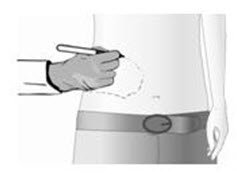
- If necessary, clip hair (do not shave) in and around the identified treatment area to promote QUTENZA adherence.
- QUTENZA can be cut to match the size and shape of the treatment area. Gently wash the treatment area with mild soap and water, and dry thoroughly.
Anesthetize (optional)
- The treatment area may be pretreated with a topical anesthetic to potentially reduce discomfort associated with the application of QUTENZA.
- Apply topical anesthetic to the entire treatment area and surrounding 1 to 2 cm, and keep the local anesthetic in place until the skin is anesthetized prior to the application of QUTENZA.
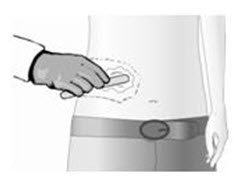
- Remove the topical anesthetic with a dry wipe. Gently wash the treatment area with mild soap and water, and dry thoroughly.
Apply
- Tear open the pouch along the three dashed lines and remove QUTENZA.
- Inspect QUTENZA and identify the outer surface backing layer with the printing on one side and the capsaicin-containing adhesive on the other side. The adhesive side of QUTENZA is covered by a clear, unprinted, diagonally cut release liner.
- Cut QUTENZA before removing the protective release liner. Ensure that unused pieces do not make contact with other objects and are disposed of appropriately.
- The diagonal cut in the release liner is to aid in its removal. Peel a small section of the release liner back and place the adhesive side of QUTENZA on the treatment area.
- While you slowly peel back the release liner from under the QUTENZA with one hand, use your other hand to smooth QUTENZA down onto the skin.
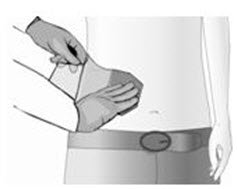
- Once QUTENZA is applied, leave in place for 60 minutes (PHN).
- To ensure QUTENZA maintains contact with the treatment area, a dressing, such as rolled gauze, may be used. Remove the nitrile gloves after the application.
- Instruct the patient not to touch QUTENZA or the treatment area.
Remove
- Put on nitrile (not latex) gloves. Remove QUTENZA by gently and slowly rolling inward.
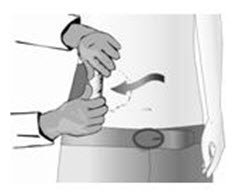
Cleanse
- After removal of QUTENZA, generously apply Cleansing Gel to the treatment area and leave on for at least one minute. Remove Cleansing Gel with a dry wipe and gently wash the area with mild soap and water. Dry thoroughly.
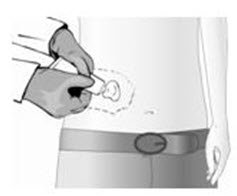
- Dispose of all treatment materials as described .
- Inform the patient that the treated area may be sensitive for a few days to heat (e.g., hot showers/baths, direct sunlight, vigorous exercise).
|
USE IN NEUROPATHIC PAIN ASSOCIATED WITH DIABETIC PERIPHERAL NEUROPATHY
(30-MINUTE APPLICATION TIME ON THE FEET)
Prepare
- Administer QUTENZA in a well-ventilated treatment area.
- Put on nitrile (not latex) gloves. Use of a face mask and protective glasses is advisable for healthcare professionals.
- Inspect the pouch. Do not use if the pouch has been torn or damaged.
Identify
- The treatment area (painful area including areas of hypersensitivity and allodynia) must be identified by a physician or healthcare professional and marked on the skin.
- Examine the feet prior to application of QUTENZA to detect skin lesions related to underlying neuropathy or vascular insufficiency.

- If necessary, clip hair (do not shave) in and around the identified treatment area to promote QUTENZA adherence.
- QUTENZA can be cut to match the size and shape of the treatment area. Gently wash the treatment area with mild soap and water, and dry thoroughly.
Anesthetize (optional)
- The treatment area may be pretreated with a topical anesthetic to potentially reduce discomfort associated with the application of QUTENZA.
- Apply topical anesthetic to the entire treatment area and surrounding 1 to 2 cm, and keep the local anesthetic in place until the skin is anesthetized prior to the application of QUTENZA.

- Remove the topical anesthetic with a dry wipe. Gently wash the treatment area with mild soap and water, and dry thoroughly.
Apply
- Tear open the pouch along the three dashed lines and remove QUTENZA.
- Inspect QUTENZA and identify the outer surface backing layer with the printing on one side and the capsaicin-containing adhesive on the other side. The adhesive side of QUTENZA is covered by a clear, unprinted, diagonally cut release liner.
- Cut QUTENZA before removing the protective release liner. Ensure that unused pieces do not make contact with other objects and are disposed of appropriately.
- The diagonal cut in the release liner is to aid in its removal. Peel a small section of the release liner back and place the adhesive side of QUTENZA on the treatment area.
- While you slowly peel back the release liner from under the QUTENZA with one hand, use your other hand to smooth QUTENZA down onto the skin.
- QUTENZA can be wrapped around the dorsal, lateral, and plantar surfaces of each foot to completely cover the treatment area.

- Once QUTENZA is applied, leave in place for 30 minutes on the feet (DPN).
- To ensure QUTENZA maintains contact with the treatment area, a dressing, such as rolled gauze, may be used. Remove the nitrile gloves after the application.
- Instruct the patient not to touch QUTENZA or the treatment area.
Remove
- Put on nitrile (not latex) gloves. Remove QUTENZA by gently and slowly rolling inward.

Cleanse
- After removal of QUTENZA, generously apply Cleansing Gel to the treatment area and leave on for at least one minute. Remove Cleansing Gel with a dry wipe and gently wash the area with mild soap and water. Dry thoroughly.

- Dispose of all treatment materials as described .
- Inform the patient that the treated area may be sensitive for a few days to heat (e.g., hot showers/baths, direct sunlight, vigorous exercise).
|
Does Qutenza interact with my other drugs?
Enter medications to view a detailed interaction report using our Drug Interaction Checker.
Frequently asked questions
See also:
Further information
Always consult your healthcare provider to ensure the information displayed on this page applies to your personal circumstances.
Medical Disclaimer











